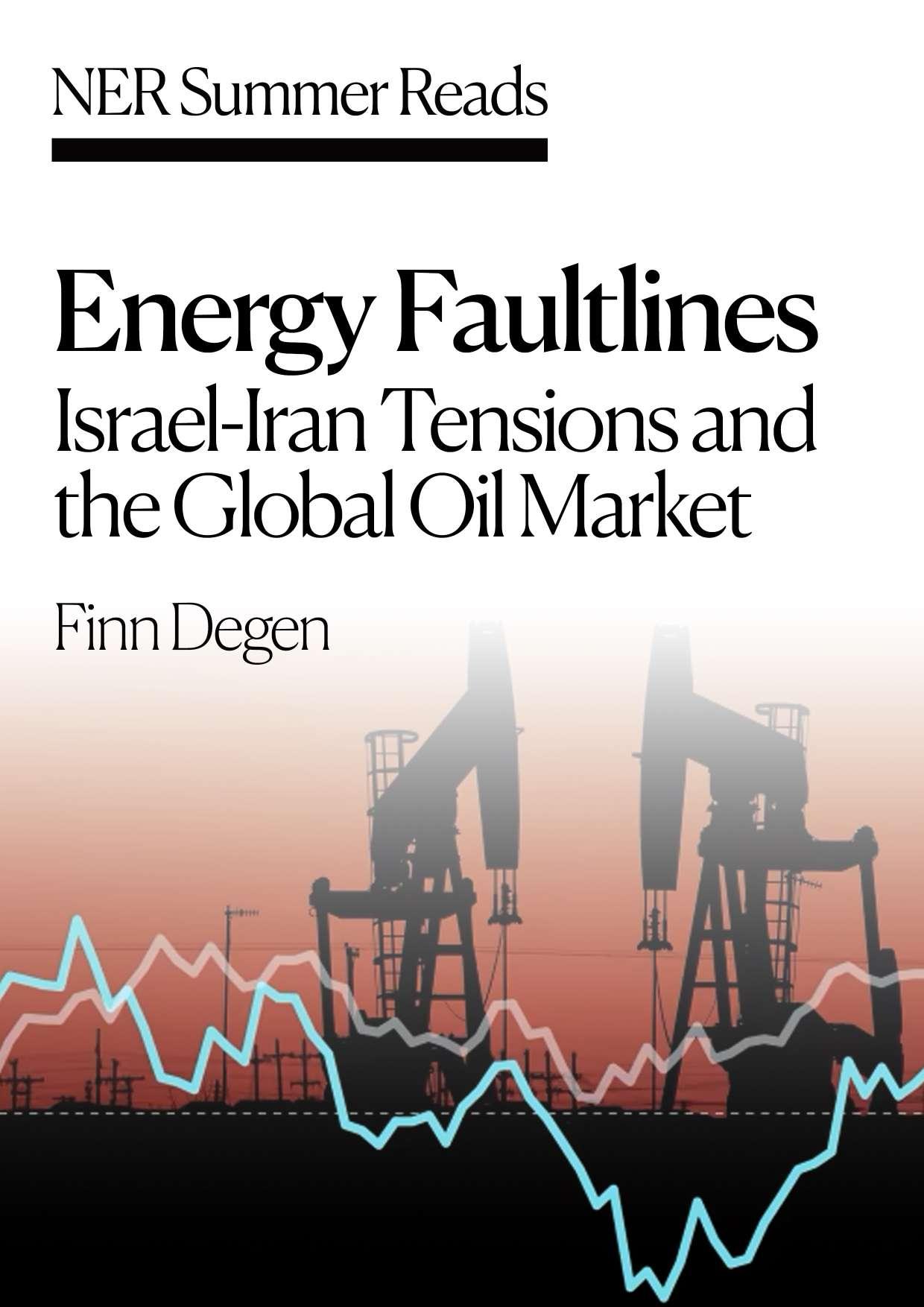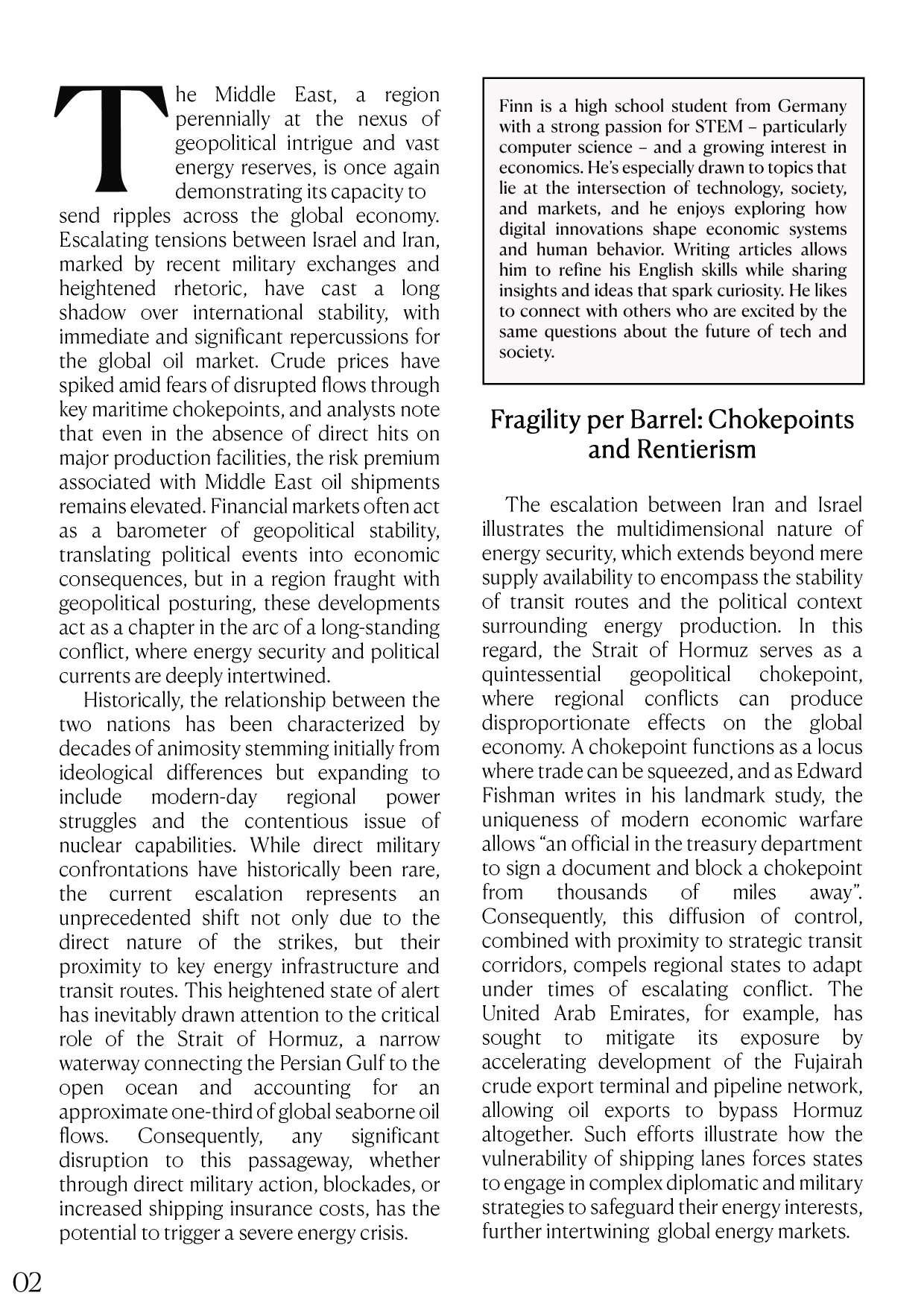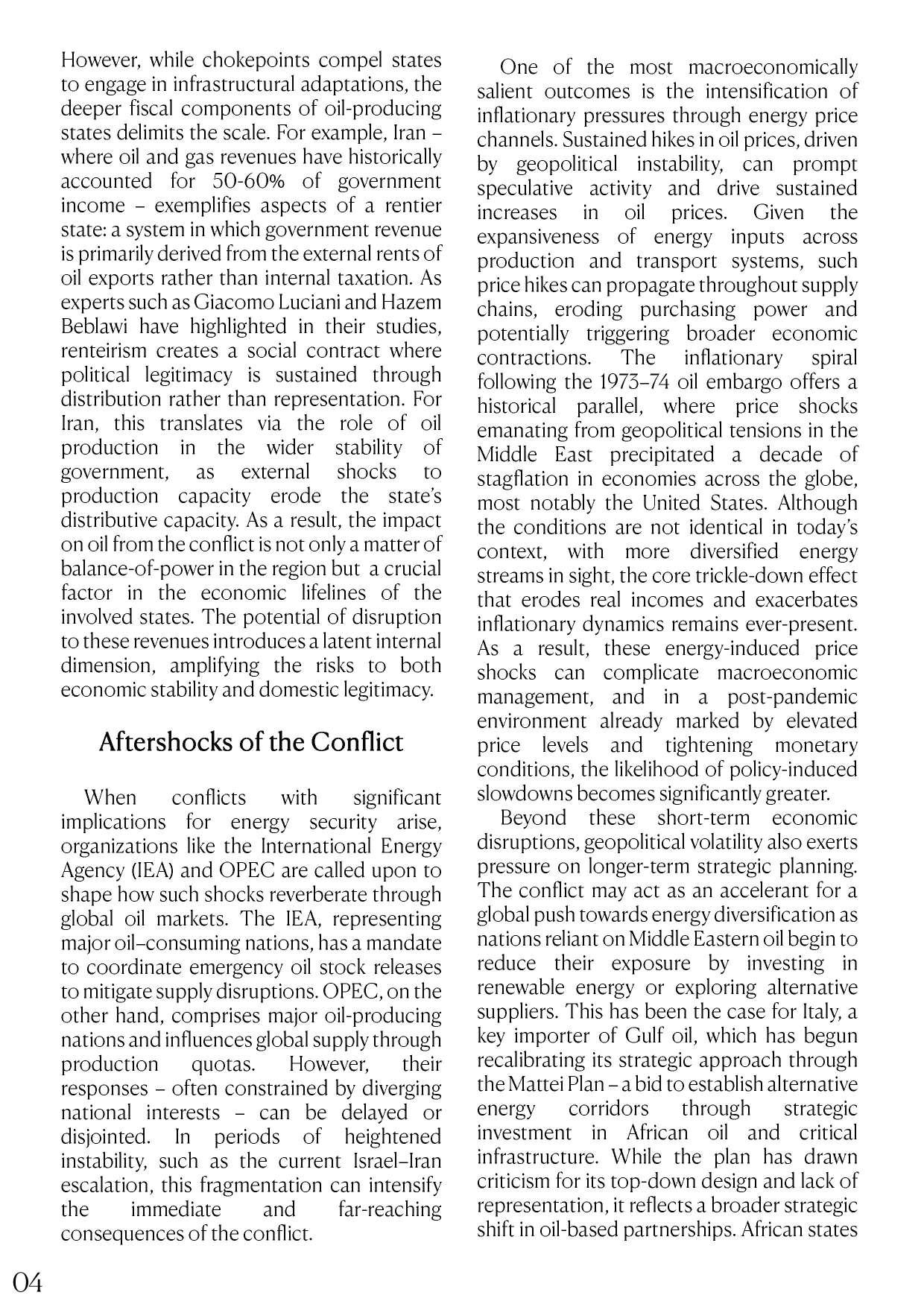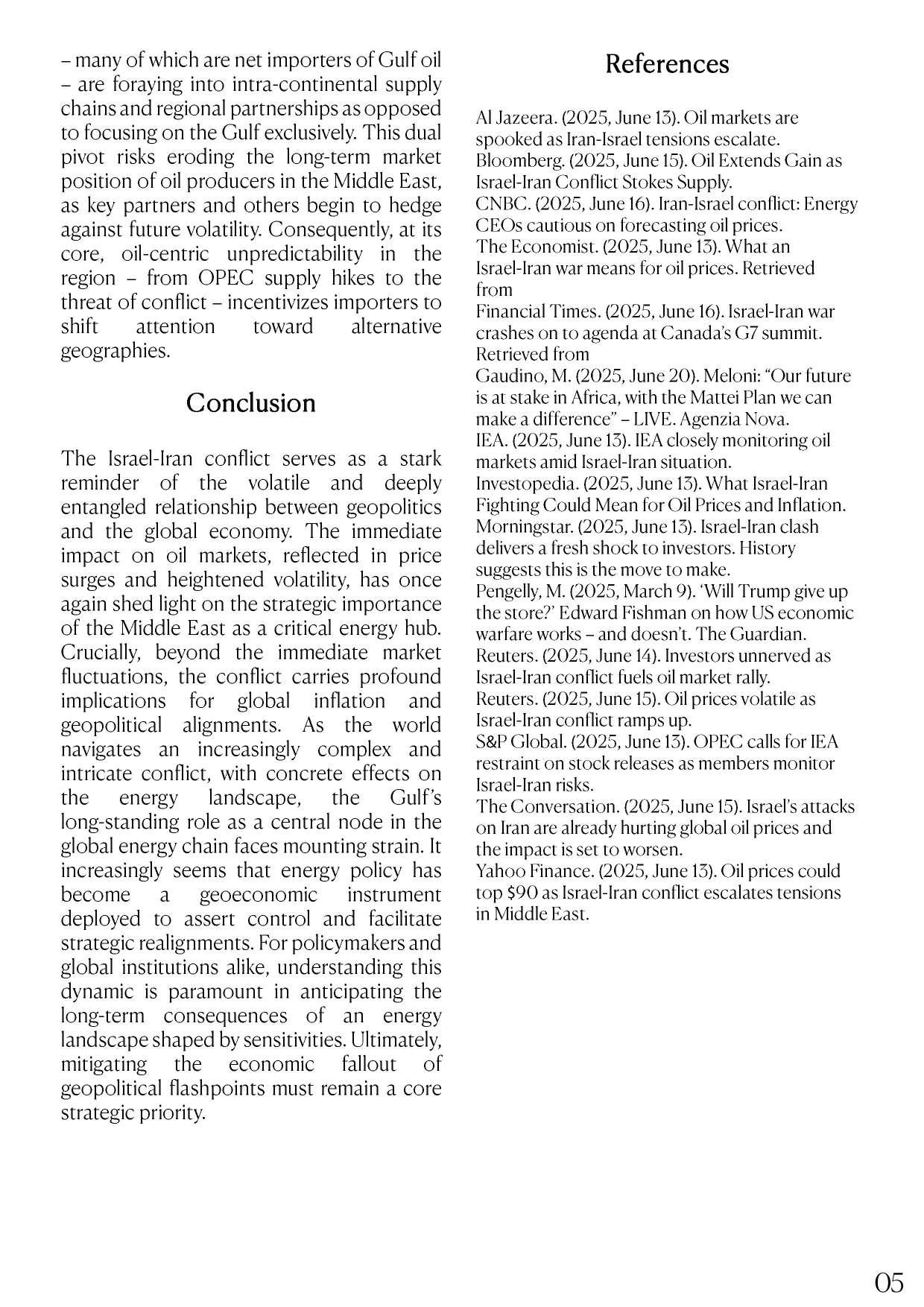

Energy Faultlines
Israel-Iran Tensions and the Global Oil Market
Finn Degen

The Middle East, a region perennially at the nexus of
geopolitical intrigue and vast energy reserves, is once again demonstrating its capacity to send ripples across the global economy. Escalating tensions between Israel and Iran, marked by recent military exchanges and heightened rhetoric, have cast a long shadow over international stability, with immediate and significant repercussions for the global oil market. Crude prices have spiked amid fears of disrupted flows through key maritime chokepoints, and analysts note that even in the absence of direct hits on major production facilities, the risk premium associated with Middle East oil shipments remains elevated. Financial markets often act as a barometer of geopolitical stability, translating political events into economic consequences, but in a region fraught with geopolitical posturing, these developments act as a chapter in the arc of a long-standing conflict, where energy security and political currents are deeply intertwined.
Historically, the relationship between the two nations has been characterized by decades of animosity stemming initially from ideological differences but expanding to include modern-day regional power struggles and the contentious issue of nuclear capabilities. While direct military confrontations have historically been rare, the current escalation represents an unprecedented shift not only due to the direct nature of the strikes, but their proximity to key energy infrastructure and transit routes. This heightened state of alert has inevitably drawn attention to the critical role of the Strait of Hormuz, a narrow waterway connecting the Persian Gulf to the open ocean and accounting for an approximate one-third of global seaborne oil flows. Consequently, any significant disruption to this passageway, whether through direct military action, blockades, or increased shipping insurance costs, has the potential to trigger a severe energy crisis.
Finn is a high school student from Germany with a strong passion for STEM - particularly computer science - and a growing interest in economics. He's especially drawn to topics that lie at the intersection of technology, society, and markets, and he enjoys exploring how digital innovations shape economic systems and human behavior. Writing articles allows him to refine his English skills while sharing insights and ideas that spark curiosity. He likes to connect with others who are excited by the same questions about the future of tech and society.
Fragility per Barrel: Chokepoints and Rentierism
The escalation between Iran and Israel illustrates the multidimensional nature of energy security,which extends beyond mere supply availability to encompass the stability of transit routes and the political context surrounding energy production. In this regard, the Strait of Hormuz serves as a quintessential geopolitical chokepoint, where regional conflicts can produce disproportionate effects on the global economy. A chokepoint functions as a locus where trade can be squeezed, and as Edward Fishman writes in his landmark study, the uniqueness of modern economic warfare allows "an official in the treasury department to sign a document and block a chokepoint from thousands of miles away". Consequently, this diffusion of control, combined with proximity to strategic transit corridors, compels regional states to adapt under times of escalating conflict. The United Arab Emirates, for example, has sought to mitigate its exposure by accelerating development of the Fujairah crude export terminal and pipeline network, allowing oil exports to bypass Hormuz altogether. Such efforts illustrate how the vulnerability of shipping lanes forces states to engage in complex diplomatic and military strategies to safeguard their energy interests, further intertwining global energy markets.


However, while chokepoints compel states to engage in infrastructural adaptations, the deeper fiscal components of oil-producing states delimits the scale. For example, Iranwhere oil and gas revenues have historically accounted for 50-60% of government income - exemplifies aspects of a rentier state:a system in which government revenue is primarily derived from the external rents of oil exports rather than internal taxation. As experts such as Giacomo Luciani and Hazem Beblawi have highlighted in their studies, renteirism creates a social contract where political legitimacy is sustained through distribution rather than representation. For Iran, this translates via the role of oil production in the wider stability of government, as external shocks to production capacity erode the state's distributive capacity. As a result, the impact on oil fromthe conflict is not onlya matter of balance-of-power in the region but a crucial factor in the economic lifelines of the involved states. The potential of disruption to these revenues introduces a latent internal dimension, amplifying the risks to both economic stability and domestic legitimacy.
Aftershocks of the Conflict
When conflicts with significant implications for energy security arise, organizations like the International Energy Agency (IEA) and OPEC are called upon to shape how such shocks reverberate through global oil markets. The IEA, representing major oil-consuming nations, has a mandate to coordinate emergency oil stock releases to mitigate supply disruptions. OPEC, on the other hand, comprises major oil-producing nations and influences global supply through production quotas. However, their responses - often constrained by diverging national interests - can be delayed or disjointed. In periods of heightened instability, such as the current Israel-Iran escalation, this fragmentation can intensify the immediate and far-reaching consequences ofthe conflict.
One of the most macroeconomically salient outcomes is the intensification of inflationary pressures through energy pric channels. Sustained hikes in oil prices, driven by geopolitical instability, can prompt speculative activity and drive sustained increases in oil prices. Given the expansiveness of energy inputs across production and transport systems, such price hikes can propagate throughout supply chains, eroding purchasing power and potentially triggering broader economic contractions. The inflationary spiral following the 1973-74 oil embargo offers a historical parallel, where price shocks emanating from geopolitical tensions in the Middle East precipitated a decade of stagflation in economies across the globe, most notably the United States. Although the conditions are not identical in today's context, with more diversified energy streams in sight, the core trickle-down effect that erodes real incomes and exacerbates inflationary dynamics remains ever-present. As a result, these energy-induced price shocks can complicate macroeconomic management, and in a post-pandemic environment already marked by elevated price levels and tightening monetary conditions, the likelihood of policy-induced slowdowns becomes significantly greater.
Beyond these short-term economic disruptions, geopolitical volatility also exerts pressure on longer-term strategic planning. The conflict may act as an accelerant for a global push towards energy diversification as nations reliant on Middle Eastern oil begin to reduce their exposure by investing in renewable energy or exploring alternative suppliers. This has been the case for Italy, a key importer of Gulf oil, which has begun recalibrating its strategic approach through theMattei Plan - a bid to establish alternative energy corridors through strategic investment in African oil and critical infrastructure. While the plan has drawn criticism for its top-down design and lack of representation, it reflects a broader strategic shift in oil-based partnerships. African states


